No federal forms, meat for the pot with home-made gear – and maybe even ammunition!
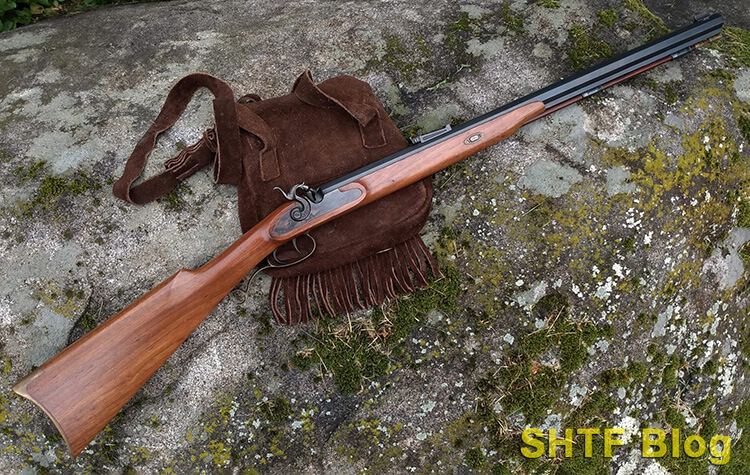
Several months ago, a .32 caliber muzzleloader arrived at my doorstep, packed in a cardboard box. I’d purchased it through an online gun auction site after another futile search for reloading components. Per the norm, local gun stores were picked clean but, surprisingly, one had a decent assortment of muzzleloading supplies.
That windfall, along with items gathering dust in my basement, provided the final nudge that culminated in a small percussion rifle: Thompson Center’s no-longer produced .32-caliber Cherokee. Several days after its arrival, I jumped back in my truck and made a beeline to the same shop with fingers crossed.
Still no metallic ammunition components, and not much loaded ammo, but I left with several boxes of Hornady’s swaged lead round balls, a couple tins of #11 percussion caps, pre-lubed patches – and enough money left over for lunch.
To my mind, the trim little caplock’s blued barrel, walnut stock, and brass furniture were a whole lot prettier than a recent tactical Tupperware purchase. No FFL or federal forms required either! I just mailed a certified check and tracked the rifle’s journey to my address.
.32 Caliber Muzzleloader Downsides and Upsides
Admittedly, a gun like this isn’t for everyone. Those into sending voluminous quantities of lead downrange will be happier with a different system. Traditional muzzleloaders are fiddly firearms that demand gear and extra attention. They’re also poorer choices for those who procrastinate on cleaning their firearms.
In fact, fouling accumulates so quickly that most .32s must be wiped with at least one cleaning patch between each shot. Today’s cartridge firearms obsoleted muzzleloaders for a reason – they’re a whole lot easier to use! Another deal killer for many: Small calibers (like the .32) don’t have enough power to handle deer-size game.
Now for the upsides.
As noted above, because black powder rifles are considered antique firearms, no FFL is required for the purchase of muzzleloading guns, and there are usually fewer local restrictions. You could also make just about all of the necessary gear – and even most of the components. Old-timey guns receive no real negative press and offer lots of entertainment for relatively low cost.
Most of today’s muzzleloading rifles are purchased by hunters for special “black powder” deer seasons. The most popular choice by far is a .50-caliber, many of which are loaded with projectiles resembling high-power rifle bullets. The propellant is often a black powder “substitute” (sometimes in a pelletized form), ignited by a 209 shotgun primer.
These guns qualify as muzzleloaders because they’re loaded through the front – although the latest developments have even changed part of that process. But a smallbore muzzleloader isn’t that kind of rifle – not by a long-shot.

For starters, most states stipulate big game minimums that begin somewhere north of .40-caliber. This rules out .36 and .32-caliber front-stuffers for deer although turkeys are legal in some states. However, varmints and small game animals are legal just about everywhere, to include some spots where conventional rifles are prohibited.
But, unless you’re into shredded meat, bullet-type projectiles are seldom the best choice. For that matter, even lead round-balls can be devasting at a relatively moderate velocity.
Small Caliber Adventures
During the late ‘80s, my area had few gray squirrels but plenty of snowshoe hares. The season was lengthy and bag limits were generous, so a small caliber muzzleloading rifle seemed like the ticket for midwinter adventures. After stumbling onto an elegant Thompson Center .36-caliber Seneca percussion rifle I snatched it up; however, results on our fluffy white bunnies were catastrophic.
Reducing the powder charge didn’t seem to help with .36-caliber patched balls. Although only half the weight of T/C’s Max-Ball bullets, results were still messy – even with greatly reduced charges (now lost to time), so I finally gave up on the .36 Seneca.
The 1980s were the heyday of Thompson Center’s muzzleloading production. Shortly thereafter, I bought a similar T/C .32 Cherokee (identical to the one pictured above). Although its accuracy was surprisingly good, once again, the terminal effect was rabbit-burger (actually, they’re hares).
Throttling the little 46-grain ball down to 20-grains helped, but the culinary aspect was greatly improved through mild 15-grain charges.
Finally, with success at hand, the ramrod became lodged in the barrel during a cleaning session. The fix required a T/C breech-plug wrench and some serious elbow grease – at which point the rod passed effortlessly through the barrel. The cause was presumed to be a mechanical lock between the patched jag and an interior shoulder.
Freed at last, the threads were coated with an anti-seize compound, and the plug was reinstalled. Three weeks later the same fiasco happened again, and I was all done with small-caliber muzzleloaders! But bad memories tend to fade over time. Today, this bumpy chapter serves as a valuable learning experience.
.32-Caliber Muzzleloading Rifles
The latest T/C Cherokee has been used but not abused. I bought it mainly because of its hooked-breech design. That permits easy removal of the barrel by tapping out a forend wedge. This feature simplifies cleaning with traditional hot water methods. At only 40-inches in length with a weight of 6 pounds, it’s also a handy woods companion.
The barrel is a relatively short 24-inches, rifled with a fairly quick 1×30 twist – another reason I held out for a Cherokee. It fires via two options provided by its classic “set trigger.” Squeeze the front and the rifle will fire normally with a four-pound pull. Press the rear trigger until it clicks, and the front will become “set” to fire from an extremely light “hair-trigger.”
First thing I did was replace the factory ramrod with my old vice-grip scarred synthetic aftermarket version, which had a hole drilled through its muzzle end (if not, I would’ve drilled one for use of a makeshift T-handle). As another precaution, instead of a drum-type patch jag, I used a slotted tip. Finally, through trial and error, I established a snag-free patch fit. Truthfully, the easier alternative would’ve been to buy a current .32 rifle.
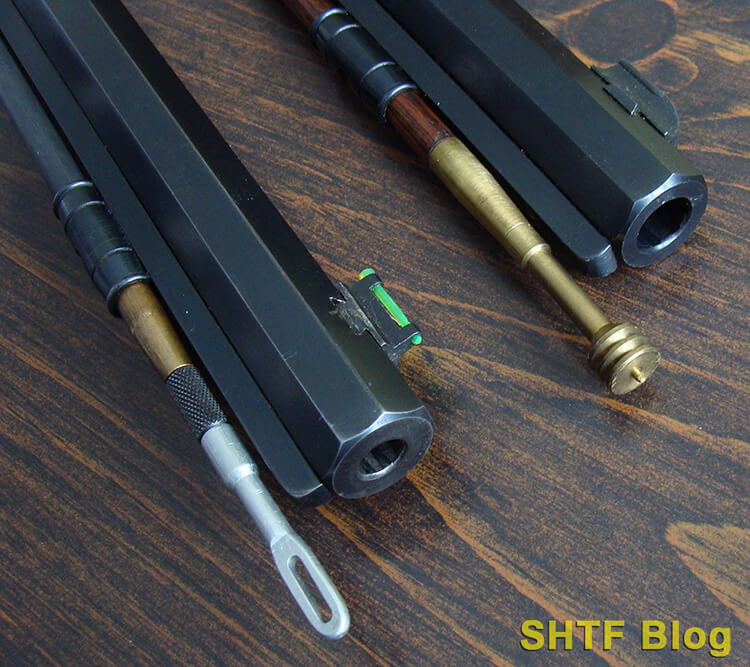
Today’s .32 Rifles
Small-caliber options are somewhat limited, but Traditions sells a trim .32 caliber caplock; the Crockett, available as complete rifle, or as a kit. It’s not hooked-breech design, but it does incorporate a wedge. The barrel can be separated from the stock after removing one screw in the breech-plug’s tang.
It also ships with a sturdy aluminum ramrod. Factory-built Crocketts are available for around $500, available via mail order for shipment to your address.
For more cost, Pedersoli offers attractive .32-caliber rifles in various configurations, to include both percussion and flintlock versions. Their full-length stocks are secured using pins, a common method in years gone by. Dixie Gun Works also sells a line of Pedersoli-built small-bores, along with a huge assortment of accessories. The site also covers cleaning methods.
What it Takes to Fire a Shot
The big caution: Conventional smokeless propellants are out! Their high pressures will blow a traditional muzzleloading firearm to smithereens – probably with serious injury to the shooter!
These guns are designed for black powder, or a short list of approved modern substitutes. And contrary to a popular myth, an excessive charge can destroy a muzzleloading gun.
The loading process begins by pouring a measured charge of powder into the muzzle (never directly from the main container). Next comes the projectile, in this case a lead roundball, which works best if wrapped in a lubricated patch – the part that actually engages the rifling.
The patch is placed above the muzzle, followed by the ball. Because optimum accuracy requires a snug fit, the ball is pressed into the barrel using a “ball starter” (see photos). From there, full seating is accomplished via the ramrod. The loading process is completed after a percussion cap is pressed on to the nipple.
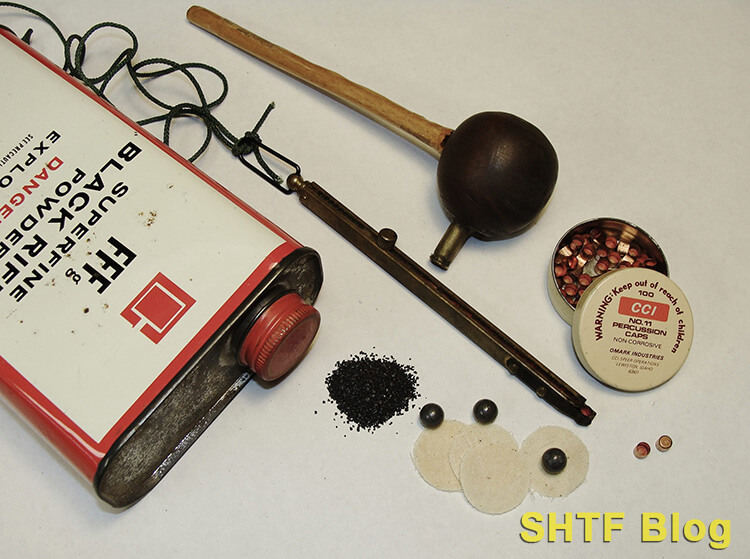
Components
Actually, you could make all of the necessary components – including powder and the percussion caps! I’ll skip the powder, thanks, but here’s a video on how to make caps:
A flintlock goes bang with a rock, so it could be the ultimate hard-times survival gun (see below), but the percussion cap replaced this system because its simpler and more weatherproof. Here’s the list of components.
Powder
Black powder is sold in granulations running from coarse F-G through fine FFFF-G. I’m still into a ten-year-old one-pound can of GOEX FFF-G. Although currently unavailable, it’s due to return.
Meanwhile, other black powder choices exist for around $25 per pound. A moderately zippy 20-grain charge will provide 350 shots, but some squirrel hunters use 10 grains.
Alliant Powder’s Black MZ supposedly works, although it’s been in and out of circulation. Others use more corrosive Pyrodex-P, which is granulated for pistols.
Projectiles
I bought a few boxes (100 each) of Hornady swaged lead balls in .310 and .315 diameters for $10 per box. Others use 0-Buck, or cast their own using simple molds and scrap lead from chimney flashing, etc.
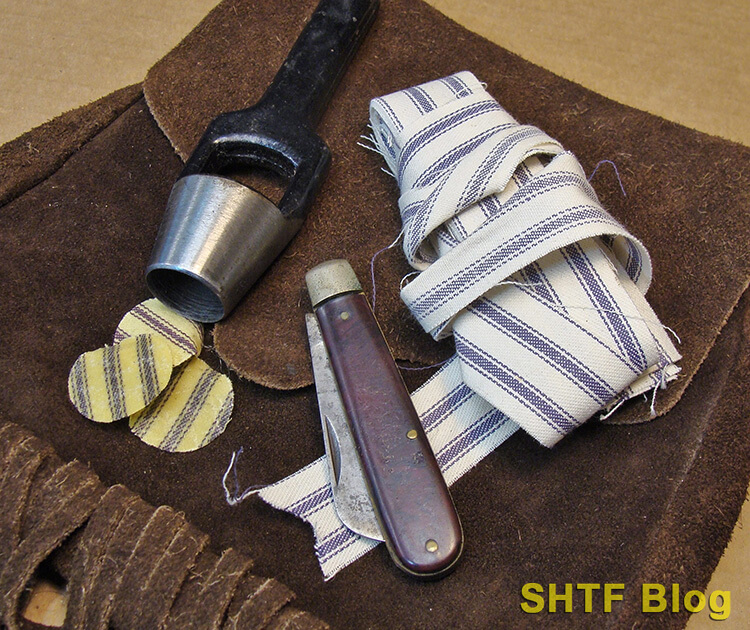
Patches
Between shooting and cleaning, you can go through a bunch. I grabbed a few bags (100 each) of 0.010” thick, 1” diameter, pre-lubed patches for shooting purposes, but I’ll eventually make my own (via a hollow steel punch of the same diameter).
A patch should fit snugly without burning through (determined by recovered specimens). Pillow ticking has long served well. For wiping and final cleaning, I use separate cotton patches (T-shirts will work).
Percussion Caps
My rifle takes common #11s, which are sold in small tins of 100 each. I bought a tin of Remingtons for $8, but my old stash of CCIs turned out to be the better fit; or start saving aluminum beverage cans and make your own caps!
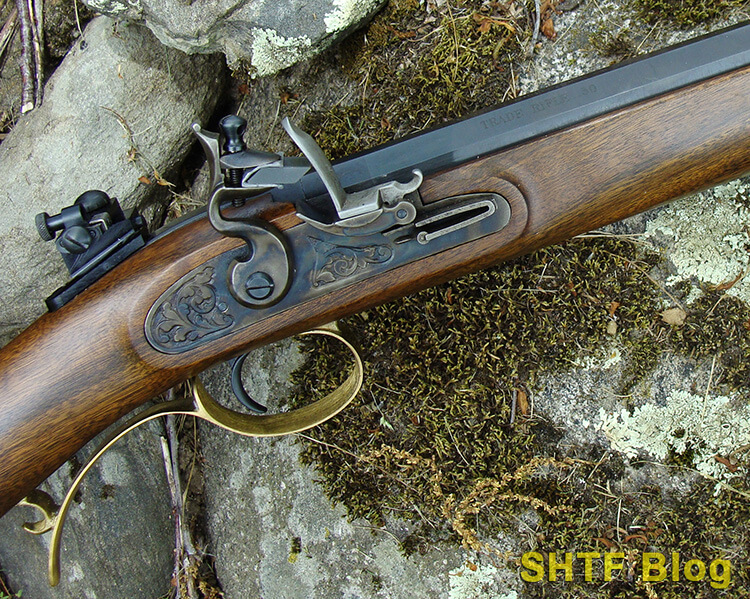
Flintlock Notes and Accessories
Flintlock loading procedures are similar except for the last step. Ignition requires a separate priming charge, deposited in the lock’s pan, to receive a shower of sparks when the flint strikes a steel frizzen. Extras include spare flints and a small pan-charger. See my article on how to load a flintlock rifle for more information.
A few items qualify as essentials; however, most can be easily made. A commercial “capper” is worth buying because small percussion caps are so darn fiddly. A nipple wrench provides an easy way to unscrew a nipple for maintenance or replacement. The most critical item is powder measure.
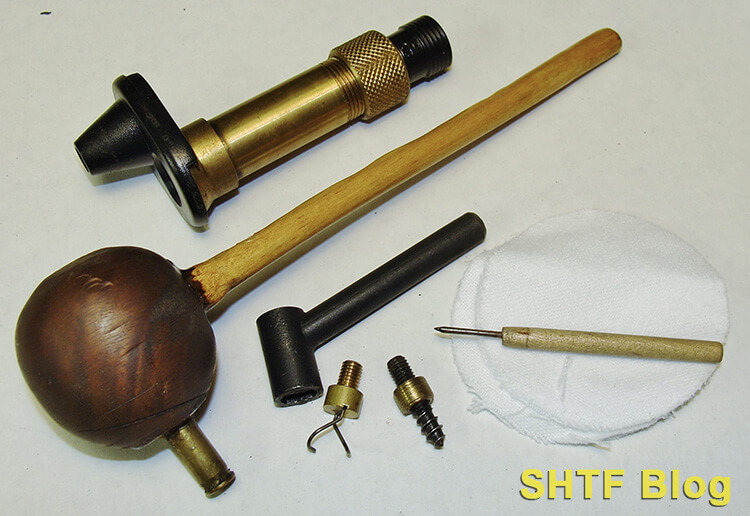
Powder Measures
Adjustable measures can be set to pour a specified charge of black powder. But, if you have access to a reloading scale, you can come pretty close with a scoop. Some shooters make their own from a fired case (like a .357 Magnum), with a simple wire handle soldered on.
I’ve made preassembled “cartridges” from clear gas tubing but, so far, for this .32, I’ve been using pre-weighed charges in .308 cases, plugged with 5/16” dowel chunks (tapered by a pencil sharpener).
Other Essentials
These include the ball starter, vent pick, patch jag, and patch lube (beyond commercial choices, there’s always Crisco).
If you experience a brain cramp and load the ball before the powder, the solution is a ball-puller. Errant patches can be fished out by a patch-worm.A classic “possibles bag” offers a handy way to carry these items (my wife’s purse would probably work as well, but I’m not there yet).
.32 Caliber Patched-Ball Loads
The power of a .32-caliber 46-grain roundball is sometimes equated to a 40-grain rimfire cartridge because of its similar velocity and projectile weight. Maybe, but in my experience, a 46-grain ball behaves differently. A stiff charge of FFF-G can exceed 2000 fps, with enough power to take a coyote well beyond 50 yards.
As for small game, nowadays, the situation is reversed in my area. Snowshoes are scarce and gray squirrels are abundant. If a 20-grain charge will abuse a large hare, it’ll certainly hammer a squirrel – another reason why I searched for a Cherokee.
The T/C’s .32s were rifled with a 1:30 twist known to produce great accuracy at slow velocities, my 15-grain rabbit load being such an example. I could go as light as 12 grains (FFF-G) but go too low and the projectile could block the pathway from the nipple to the powder charge. Ball-puller to the rescue.

Although 20 grains a bit destructive at around 1300 fps, it could be the starting point for slower 1:48 guns like the Traditions and Pedersolis. Actually, I just zeroed my T/C for this load. Woodchuck hunting is coming, and the combination of a .315” Hornady ball/.010” lubed patch will produce three-shot 1” groups at 35 yards.
When zeroed 1” high, this load is on the money at 50 yards. Consistent accuracy and ease of loading can be maintained by wiping the bore with a spit-moistened patch between shots.
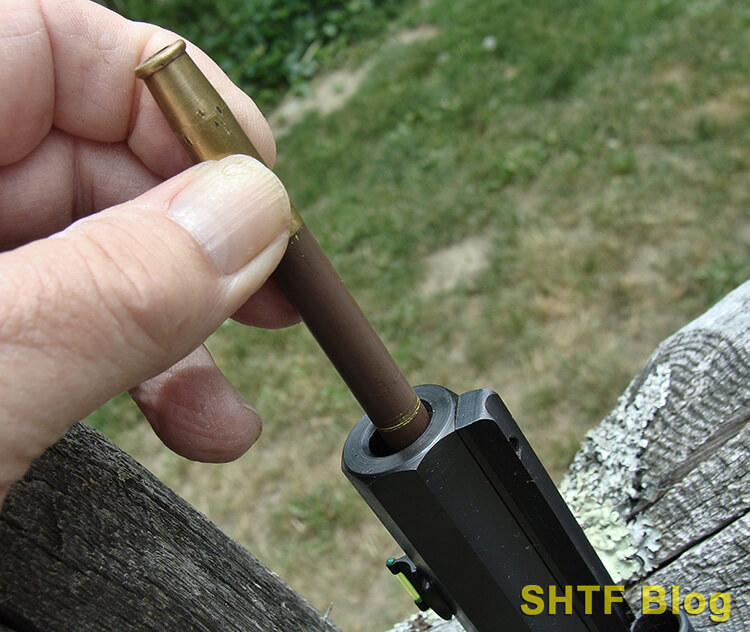
Load development is a trial-and-error process. Whatever the choice, to avoid a dangerous air gap, mark your ramrod after finalizing the load so you’ll know when the ball is fully seated.
A Sequel
Shortly after buying my T/C .32 I lucked into a spare .45-caliber barrel (part of the Cherokee line). Comparing both, one oddity of the .32 was a small 6×48 hole drilled into the rear of its breech-plug. Guessing it once held a small Lo-Pro peep-sight sold by Skinner Sights, I gave them a call.
After a nice chat with a real person, one was shipped to my address ($37). Sure enough it fit nicely, with enough allowance for elevation adjustments. Windage is adjusted by drifting the front sight.
A Sight for Old Eyes?
T/C rear sights attach with 6×48 screws instead of dovetails, so I tried the Lo-Pro in the .45 barrel. Although it’s further forward, after unscrewing its separate aperture, I gained a “ghost-ring” system perfect the woods. Another Lo-Pro, combined with a bright fiber-optic front sight, should provide a pre-zeroed .45-caliber option for an extra doe tag.
Most other muzzleloaders use dovetailed sights, but a Lo-Pro only needs one hole, so it could be the simple alternative to a vintage two-screw tang-sight system.
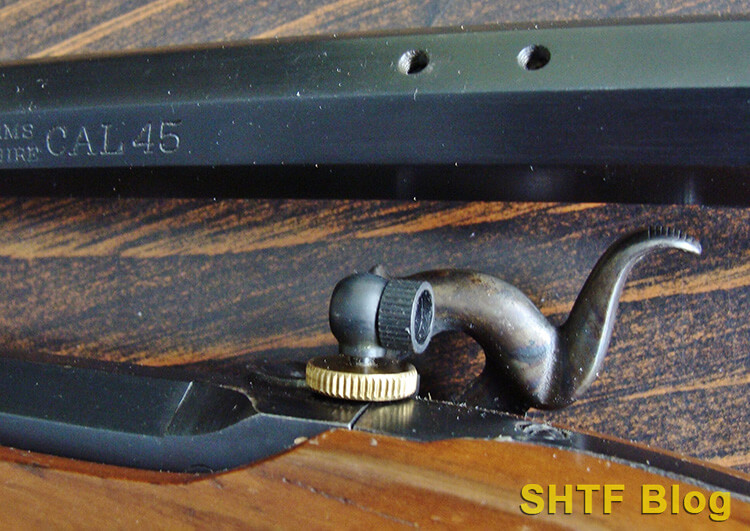
Last Blast
I fired a couple of three-shot groups while establishing a final 20-grain zero. The six total shots and necessary cleaning session afterward consumed most of an afternoon. But it was also an entirely enjoyable process that cost next to nothing. This even included the solvent – a bucket of hot water.
As a final note, the residue (fouling) left by black powder is corrosive. The cleaning process isn’t rocket science but it shouldn’t be delayed. You can click on my article on how to clean a flintlock rifle for more information.

1 comment
Nice! been shooting black powder at the age of 3, almost 4.Dad would take me to the gun club, I had a bag witha 36 cal navy cap and ball. All the guys on the black powder ranged laughed but each man took his turn loading it for me.